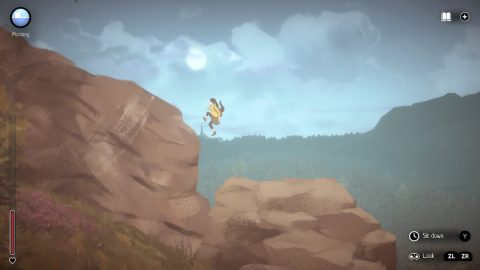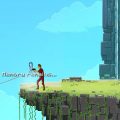While there are more genres of games than ever before, most video games can still easily be slotted into a single genre. Even when there’s variation within the genre, we still get things like “farming game, except it’s in space” and “farming game, except with dinosaurs.” But sometimes you get a game whose genre is extremely hard to classify. Such is the case with A Highland Song, which contains elements of cinematic platforming, adventure, survival, and some rhythm game minigames.
Moira McKinnon is a girl living in the Scottish Highlands who has never seen the sea, and decides to leave home one day to travel to the sea and her uncle Hamish, preferably before Beltane. In fact, that’s what separates the game’s endings – if you reach Hamish before or after Beltane. Trying to get there on time is basically the game’s “hard mode” in a sense, as it is exceptionally difficult to do, especially on a first try.
But what is the actual gameplay? It can’t be summed up in a single sentence, as this game mixes a lot of ideas together in a very new way. Much of the gameplay is a 2D cinematic platformer with an emphasis on exploration both horizontally and vertically. Moira can’t jump higher than a real person, so her jumping is only over small gaps. Instead, there’s much more focus on climbing up and down things, to reach different layers of ground.
The game runs on a stamina system. What the game calls “health” is what other games might call “stamina,” though it essentially doubles as life. The things that make it decrease are quite varied and tie into the game’s many gameplay systems. But you can lose health from falling a long distance, from being in the rain for too long without finding shelter, from sleeping poorly, and other things. You also can run, and use up health if you run for too long without stopping to catch your breath. The one danger the game doesn’t have, that one might expect it to have, is enemies. Moira’s true enemy is nature itself.
“Wait,” you might think. “This is a cinematic platformer, yet you lose health from poor sleep and from being in the rain too long? And there are no enemies that attack you?” That’s right! A Highland Song is more of a genre mix and it has multiple gameplay systems going on that intersect with each other. Let’s take a look first at climbing, as you’ll be doing a lot of it.
The climbing system in the game is different from climbing in other games. You can’t climb forever, as you’ll start to get exhausted, indicated by a symbol over Moira’s head that indicates running out of breath. Depending on the steepness of the slope you’re currently holding onto, you might be able to recover your energy on the spot, or you might start losing health as Moira pants heavily. In some cases, it might be safer to just stop climbing entirely if your health is already low or if it’s raining.
If you find yourself slipping as you’re going downhill, you might want to jump off just before you’d hit the ground, so you can land more safely rather than crashing into the ground quickly, as that also loses you some health. And as one might expect, rain makes climbing slippery, resulting in “press button to not slip” moments, which use up Moira’s energy and raise her chances of getting exhausted. Either take the slip or use energy – it’s an on-the-spot strategic choice. If you slip too quickly and hit the ground, you lose health. Jumping right before you hit the ground prevents that.
As this world is very vertical, and many important things can be found high up in mountains, you’ll be climbing a lot. Finding the best paths to climb based on safety and efficiency, to try to get to where you need or want to be, is a big part of the gameplay. Do you climb this cliff because it’s closer to what you want, or run over there and climb up that safer one? Your choice could be the difference between saving time or saving health. To help out with that, there’s a button to zoom the camera out to survey the land more easily. On the pause menu, you can also enable a feature that highlights all the ground and climbable walls whenever the camera zooms out, so you can more easily figure out exactly what you’ll be interacting with and better plan your path.
Besides climbing, there’s other survival mechanics in the game world. Weather, and the need to sleep, both conspire to make Moira’s already difficult self-imposed mission even moreso.
Scotland rains a lot. At least it certainly does in this Scottish-developed game! Being rained on eventually starts draining your health. Hiding from the rain prevents the health drain. Do you wait out the rain and therefore pass the time? If you wait out the rain too long, not only do you raise your risk of missing Beltane and therefore getting the game’s best ending, but you also raise your risk of having to sleep, which is another matter entirely. Putting up with the rain means risking your health instead. Pick one!
Once you reach nighttime, Moira starts to get tired. Being awake for too long when you need sleep results in your health starting to drain. There are many places you’re able to sleep, but that doesn’t mean they’re all good places. If you sleep in a comfortable place, such as a house, you not only recover health from sleeping, but your health meter can even grow in size if it had previously shrunk. Sleep poorly, and while you may recover health, your maximum health will go down. Comfortable places to sleep are few and far between, however! Houses tend to be locked, but maybe you’ll have found something to unlock them…
Which leads to two other gameplay elements: inventory and choices!
There are many small sparkles that appear on the ground, and if you walk up to one and stop moving, Moira will examine it and give her thoughts, and there will often be a list of choices of things to do. Sometimes they’re things such as shouting “Echo!” in a cave, or trying to crawl into a tiny spot that’s difficult to fit through.
If there’s an item there, you can pick it up. There’s a huge variety of things you can pick up, ranging from flowers to rocks to crowbars and other things. What are they used for? Well, in addition to finding objects, you might also interact with things such as a well, a broken down boat, a locked house, or other such things. You might find the missing necklace that belonged to a man’s daughter and be able to give it to him. You might be able to enter a house and actually sleep comfortably in it! You can’t actually choose to look at your inventory at will, but instead your items are brought up in the list of choices when you have the possibility of using any of them.
Moira isn’t the only person living in these mountains, though other humans are still a rare sight. You’re more likely to find an abandoned house than an actual human. But other humans do sometimes show up and have things to say or things to give. You can choose what you want to say to them from a list of choices and usually can’t go back and do them all, and the conversation isn’t very long. Sometimes they have advice on things such as where to find hidden paths, including the path to the next mountain.
That’s a key part of the gameplay: paths. There are paths that you can find which can take you up or down the current mountain, but more importantly, there are paths that take you to the next “layer” of mountains in the distance, which is the next area. You are always trying to reach the next area, and the entrance could be anywhere, from low on the ground to high up in the mountains, to hidden in the woods. There are even hidden caves which sometimes have a hidden exit that takes you higher up the current mountain.
Sometimes paths are hinted at in one of many maps that you find. However, when you find one of those maps, you have to actually mark the location of the path yourself in the actual world, or else you risk the path not being usable when you get there. Can’t find it on the map? Then you’ll just have to search for whatever paths you’re able to find when exploring. Early maps are pretty straightforward, while later maps get increasingly tricky to figure out.
Once you find a path, you can choose it, and time will pass on the in-game clock as you move on to the next location. While that happens, you hear voiceover narration from both Moira as she talks about her memories of her uncle Hamish and the stories he told her, and Hamish as he tells his stories.
It’s not just in the narration that Moira talks, but she has a ton of in-game, unvoiced dialog. She remarks on things that she sees, complains about the burdens she experiences such as weather, lets loose with Scottish profanities (“Christ on a bike!” “It’s bloody freezing!”) which can be disabled from a menu, and describes her injuries after falling off a mountain, and even sometimes jokes to herself. All of the dialog is written to have a visual Scottish accent (e.g. “I cannae do it.” “This path is gonnae take me, like, three hours.”).
There’s a gameplay element that shows up only occasionally, despite being what the game is named after, and that’s the rhythm game aspect. From time to time, when traveling across a stretch of land with no verticality, Moira might start running automatically, and then it’s rhythm game time! As you run along the path, you’ll reach glowing circles on the ground that correspond to one of two buttons, and you have to press the buttons as you reach the circles to the beat of the music. Fail, and you lose health. These segments cover a lot of horizontal distance that would otherwise be time consuming, and without taking up much in-game time. However, if you travel back the way you came, you’ll have to repeat them in the other direction.
Finally, there are the mountain peaks. When you reach the peak of a mountain, the camera zooms out and shows you the whole land. If you have found information on the name of the mountain, you learn its true name, but if not, you can choose from a list of possibilities to personally name it. This also provides a good opportunity to scroll the camera around and mark locations that you’ve seen on maps so you can seek them out in person, including any possible hidden paths.
And that’s the basics of the game. It’s a lot of gameplay elements, and as such, it makes the game difficult to classify into a pre-existing singular genre. So, “survival cinematic platformer adventure” it is, as it contains elements of survival such as the weather and climbing and stamina-based health system, adventure such as talking to people and finding and using items, cinematic platforming in the form of the movement mechanics, and the rhythm game elements are basically a minigame that occasionally shows up.
Once you reach your uncle Hamish, you receive your ending. Did you reach him before Beltane, or did too many days pass in-game? If you’re playing for the first time, probably not. But you can start a new save and have all the marked paths and other elements from your previous run saved in the game itself for your next playthrough to make it a little bit faster. Perhaps this is what the developers meant when they said the game was based around replayability. Either way, it might take you multiple playthroughs to reach Hamish in time for Beltane, and receive the second ending.
A Highland Song is one of those rare examples of a game that takes gameplay elements and concepts and mixes them together to create what is, in a way, a totally new genre. For better or worse, it’s a fairly short game that can be finished in approximately three hours for a speedy player or longer if one is more exploration-oriented, though it could be said this short length prevents the game from stretching out too long and wearing out its welcome once it’s run out of ideas.
Being the first of its kind, its ideas could potentially be fleshed out a bit more, but that’s the risk you always take when you try a game that’s doing something truly new. It’s also sold at a low price, however, so it might be worth checking out for anyone who wants to experience what could be called the world’s first survival cinematic platformer adventure. Maybe one day, it won’t be the only game in that unusually specific genre.


